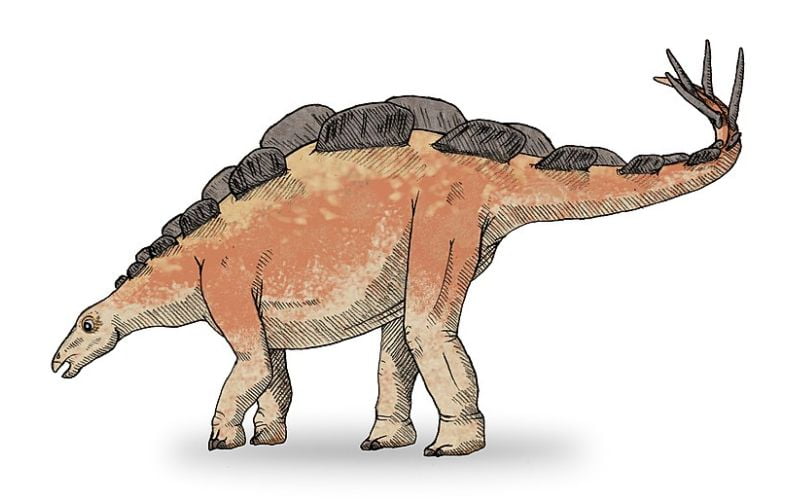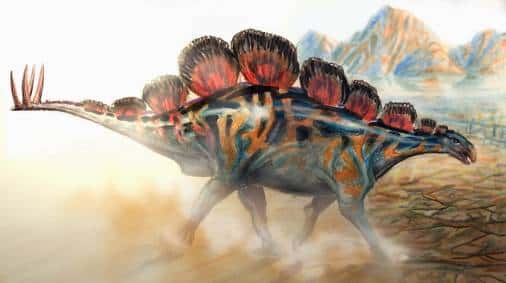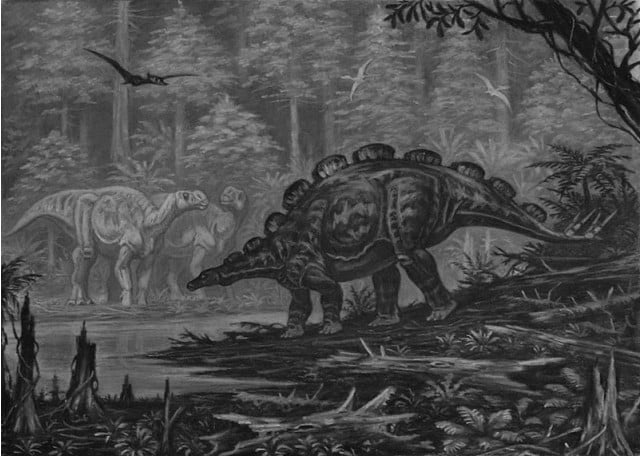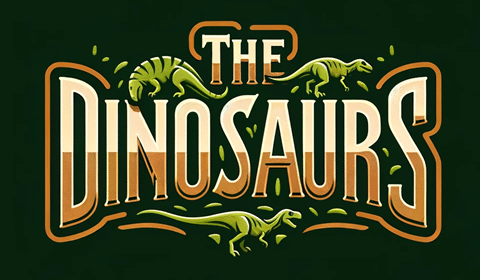Wuerhosaurus was a stegosaurid dinosaur that lived in modern day China during the Early Cretaceous period. It was among the last of the stegosaurid dinossaurs to have existed. Its taxonomy has been a source of debate among paleontologists for some time so I think it’s an interesting dino for several reasons.
Key facts
| Wuerhosaurus pronunciation | woo-uhr-huh-sore-us |
| Meaning of name | Wuerho dinosaur |
| Group | Stegosauria |
| Type Species | Wuerhosaurus homheni |
| Sub Species | W. ordosensis |
| Diet | Herbivore |
| When it Lived | 139.8 to 100.5 MYA |
| Period | Early Cretaceous |
| Epoch | Valanginian to Albian |
| Length | 23.0 ft |
| Height | 9.8 ft |
| Weight | 4.4 US tons |
| Mobility | Moved on all four |
| First Discovery | 1973 by Dong Zhiming |
| Location of first find | Xinjiang, Western China. |
| First Described by | 1973 by Dong Zhiming |
| Holotype | IVPP V.4006 |
Wuerhosaurus Taxonomy and Timeline

Wuerhosaurus, meaning the “Wuerho lizard,” gets its name from the city of Wuerho in Karamay, in a part of Western China where its fossils were discovered. The suffix “sauros” is Greek for reptile or lizard and is basically the scientific name shared by a majority of dinos.
It is part of the Stegosauria group, and Stegosauridae family. The genus Wuerhosaurus‘ type species is W. homheni, and a sub-species is the W. ordosensis.
This herbivorous dinosaur roamed Earth during the Early Cretaceous period, more specifically during the Valanginian to Albian epoch, some 139.8 to 100.5 million years ago.
It is recognized as one of the last known genera of stegosaurians. Most of its “family members” existed in the late Jurassic period, making the Wuerhosaurus a unique late survivor of its kind.
Listen to Pronunciation
Discovery & Fossil Evidence
The first discovery of Wuerhosaurus fossils dates back to 1973 and were made by Dong Zhiming in the Tugulu Group in Xinjiang, western China. Dong Zhiming didn’t just discover the fossils; he also described them in the same year, contributing significantly to our understanding of this dinosaur.
The taxonomy and description of W. homheni has been a source of debate, or difference of opinion among some paleontologists. As such I think it’s a great exampel of how describing dinosaurs, often based on a limited number of fossils and specimens, can at times result in different interpretations of the same material.
The holotype of Wuerhosaurus, labeled IVPP V.4006, was discovered in Wuerho city, Karamay, China. In this location, a second later find of W. homheni has also been made.
The fossils discovered include various parts of the dinosaur’s body, providing valuable insights into its physical characteristics and lifestyle. The holotype is a partial skeleton that provides a glimpse into its physical structure and size.
Wuerhosaurus ordosensis
In 1988, the fossilized remains of another, smaller stegosaur were discovered in Inner Mongolia, a part of Northern China. The same paleontologist, Dong Zhiming described this dinosaur in 1993, and he decided it was a sub-species of Wuerhosaurus, giving it the specific name W. ordosensis, named after the location of the find in the Ordos Basin.
Wuerhosaurus Size and Description

Wuerhosaurus was a quadrupedal dinosaur, meaning it moved on all four legs. Its body was covered in bony plates and spikes for protection, a characteristic feature of the Stegosauria group. One of the most notable specimens of Wuerhosaurus is the holotype IVPP V.4006. This specimen has significantly contributed to our understanding of this dinosaur. The partial skeleton provides valuable insights into the dinosaur’s physical structure, including its robust body and defensive features.
Size and Weight of Type Species
Wuerhosaurus was a medium-sized dinosaur if you take into account the much larger sauropods for example. Estimated to have been around 23 feet long, and weighing approximately 4.4 US tons, it was still a sizeable animal.
The Dinosaur in Detail
Wuerhosaurus had a low-slung, robust body with a long, pointed tail. Its head was small compared to its body, and it had a short neck. The spikes at the end of the tail were especially long, and are one of its most unique characteristics. The limbs of the Wuerhosaurus were stout in order to support its heavy body. Its skin likely had a rough texture similar to other dinosaurs of its kind.
Along its back it had a number of dorsal plates that has been part of the reason for varying descriptions of W. homheni. In the first description made by Dong back in 1973, based on the material at hand, it was thougt that the dorsal plates were smaller, and flatter than most other stegosaurid dinosaurs.
However, later research have led to paleontologists believing that it in fact had what would ba described as “normal” size dorsal plates. Instead, it is understood now that the retrieved dorsal plates discovered so far have been damaged, and were actually larger. This I feel is an important example of how our understanding of dinosaurs is evolving over time. Quite naturally so I might add, as both research techniques and available material also evolves.
The bony dorsal plates, no matter their size, and spikes on its body, most likely served as a defensive mechanism against predators. These features were not just for show; they were functional and vital for the dinosaur’s survival.
Another unique aspect of Wuerhosaurs is that it lived during the Early Cretaceous period, making it one of the last known genera of stegosaurians. This timeline sets it apart from most of its counterparts, which existed in the late Jurassic period.
The Wuerhosaurus in its Natural Habitat

Living during the Early Cretaceous period, it was in a time when the Earth’s climate was warm and sea levels were higher than today.
The environment was likely lush with vegetation that provided ample food for this herbivorous dinosaur. It likely fed on low-lying plants by using its small head and beak-like mouth to graze.
As a quadrupedal dinosaur, Wuerhosaurus moved on all four legs. This mode of locomotion suggests that it was a slow-moving creature that spent most of its time grazing and fending off predators with its bony plates and spikes. Its habitat was likely a mix of forests and open plains, providing both cover from predators and open grazing areas.
Like other stegosaurians, it likely had a low metabolic rate. This low metabolism, combined with its herbivorous diet, suggests that Wuerhosaurus had a relatively long life expectancy. As for its social behavior, it’s challenging to say whether it was a solitary creature or lived in herds without more comprehensive fossil evidence.
Interesting Points about Wuerhosaurus
- This is one of the last known genera of stegosaurians, surviving into the Early Cretaceous period.
- The name is derived from the city of Wuerho in Karamay, China, where its fossils were discovered.
- It was a quadrupedal dinosaur that moved on all four legs.
- The bony plates and spikes on its body served as a defensive mechanism against predators.
- The holotype, labeled IVPP V.4006, provides valuable insights into the dinosaur’s physical structure and defensive features.
Contemporary Dinosaurs
At the tail end of its lineage, this dinosaur existed alongside some of the same contemporaries its ancestors had. Among these were Camarasaurus, Allosaurus, and Apatosaurus, each contributing to the intricate dynamics of their shared environment.
Wuerhosaurus, with its distinctive armored body, might have found itself in stark contrast to the towering Camarasaurus. This colossal herbivore would have grazed on the high foliage due to its long neck serving as a natural advantage. In comparison, Wuerhosaurus, considerably smaller, would have navigated the lower vegetation in a testament to nature’s balance. Meanwhile, Apatosaurus was another giant of its time that might have been less of a direct competitor and more of a fellow denizen. The interactions between these herbivores would have been largely peaceful.
Yet, life in this ancient world was not without its perils. Allosaurus might have posed a significant threat . Its presence would have added a layer of tension to the landscape, a constant reminder of the survival of the fittest. Through this lens, we can begin to appreciate the complex and vibrant world Wuerhosaurus inhabited, a world where every creature, large or small, played a part in the symphony of prehistoric life.
List of All Dinosaurs
We have created a list of all dinosaurs we have covered here, sorted across the seven main groups of dinosaurs. We also include information about their type of diet, (omnivore, herbivore or carnivore) and the time they lived.
Frequently Asked Questions
The name means “Wuerho lizard.” It’s derived from the city of Wuerho in Karamay, China, where its fossils were discovered.
It lived during the Early Cretaceous period, from 122.46 to 100.5 million years ago.
It was an herbivore, meaning it ate plants. Its environment would have provided it plenty of vegetation to feed on.
It was a quadrupedal dinosaur, meaning it moved on all four legs.
They were found in several locations, including England, China, Portugal, Colorado, Montana, New Mexico, Oklahoma, Utah, and Wyoming.
It was first discovered in 1973 by Dong Zhiming from the Tugulu Group in Xinjiang, western China.
Sources
- https://www.chinascientificbooks.com/reports-of-paleonotogical-expedition-to-sinkiangiipeterosaurian-fauna-from-wuerho-sinkiang-p-3475/
- https://royalsocietypublishing.org/doi/10.1098/rspb.2008.1909
- https://sjg.springeropen.com/articles/10.1007/s00015-010-0023-3
- https://www.sciencedirect.com/science/article/abs/pii/S1342937X19302217
- https://www.researchgate.net/publication/241682967_A_plated_dinosaur_Ornithischia_Stegosauria_from_the_Early_Cretaceous_of_Argentina_South_America_an_evaluation
Please note that the information in this article is based on various sources, drawing on scientific research, fossil evidence, and expert analysis. The aim is to provide a comprehensive and accurate overview of the Wuerhosaurus, but please be aware that our understanding of dinosaurs and their world is constantly evolving as new discoveries are made.
This article was last fact checked: Joey Arboleda, 11-01-2025
Featured Image Credit: Debivort, CC BY-SA 3.0 https://creativecommons.org/licenses/by-sa/3.0/, via Wikimedia Commons
